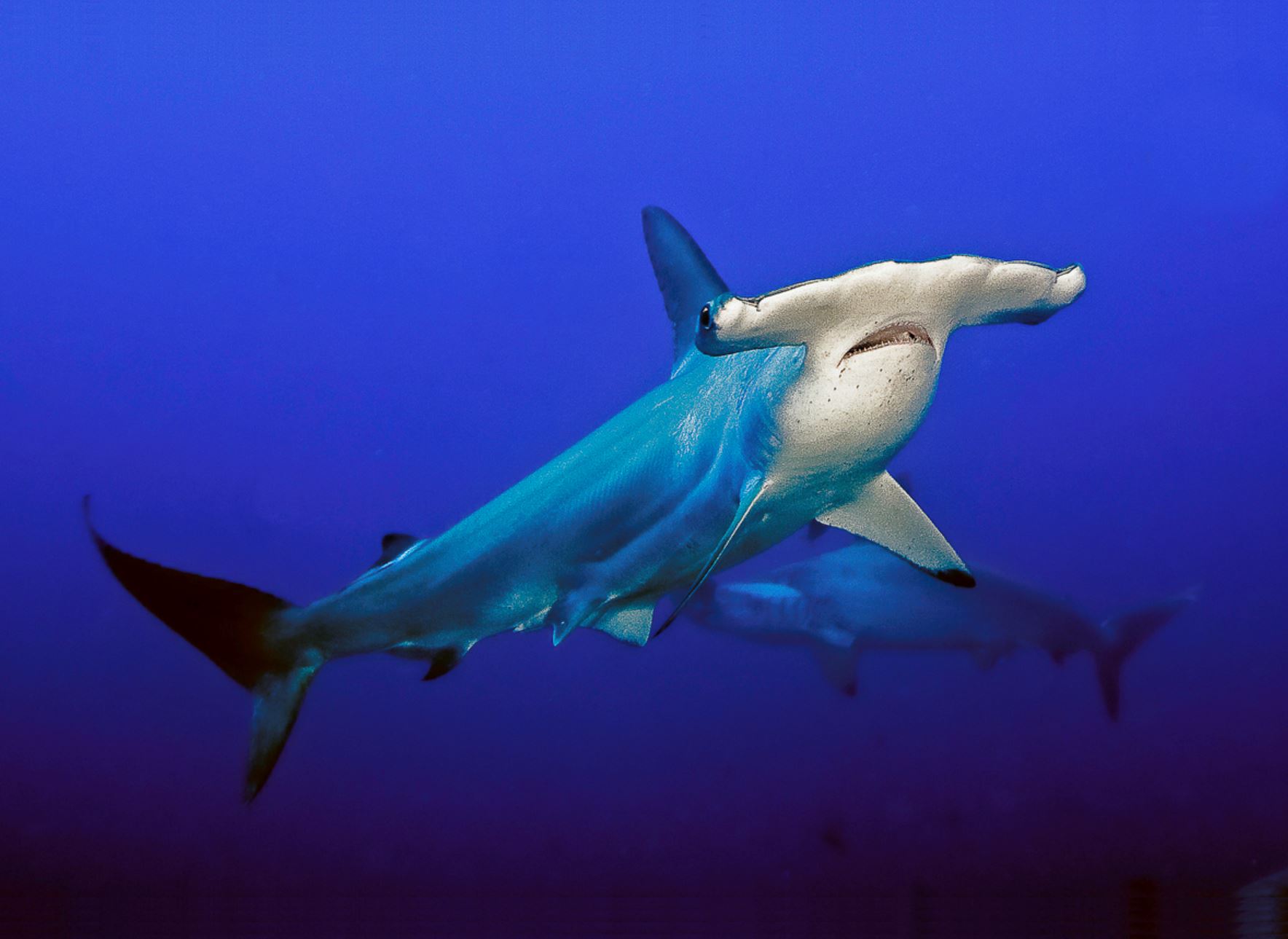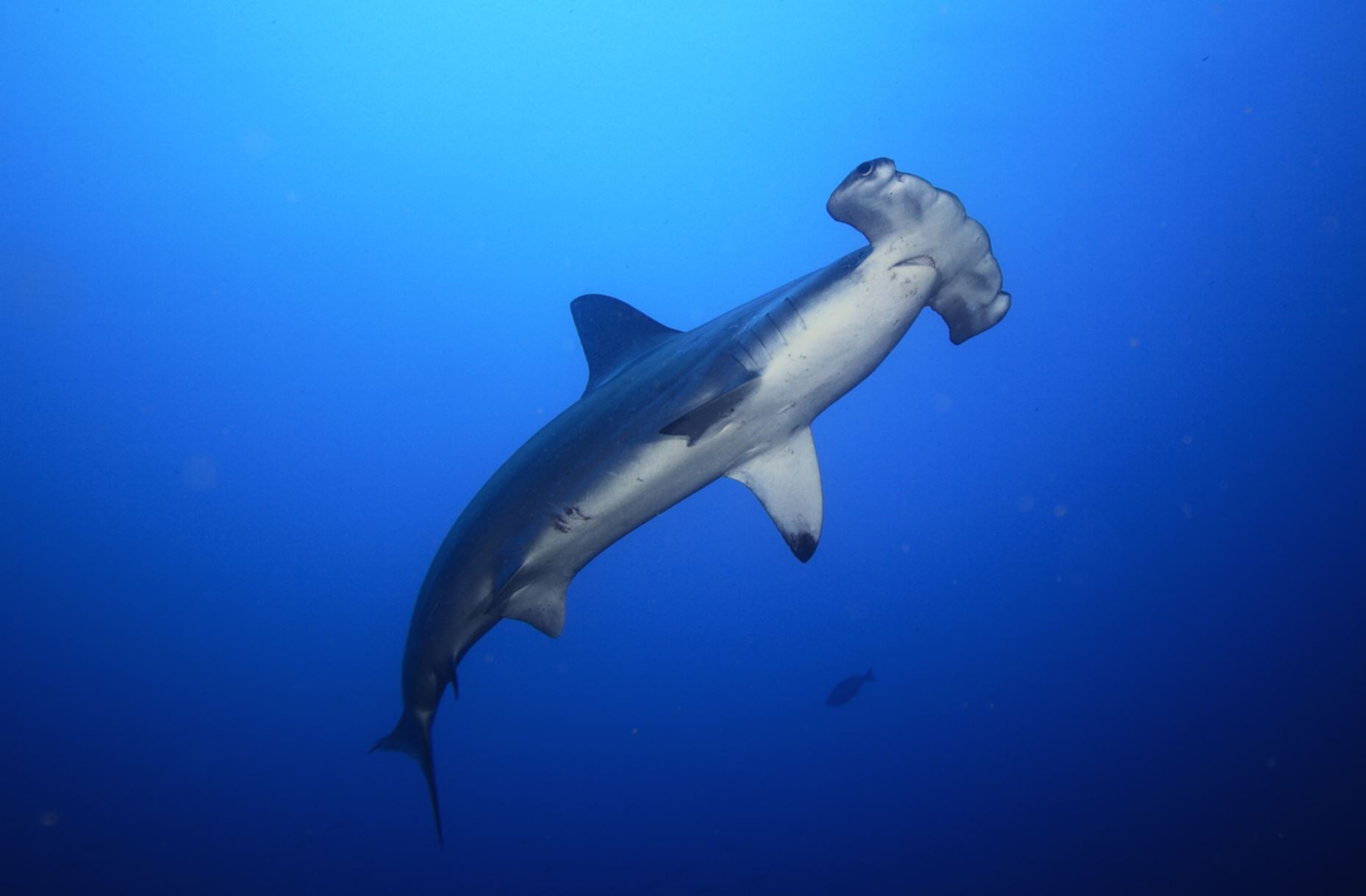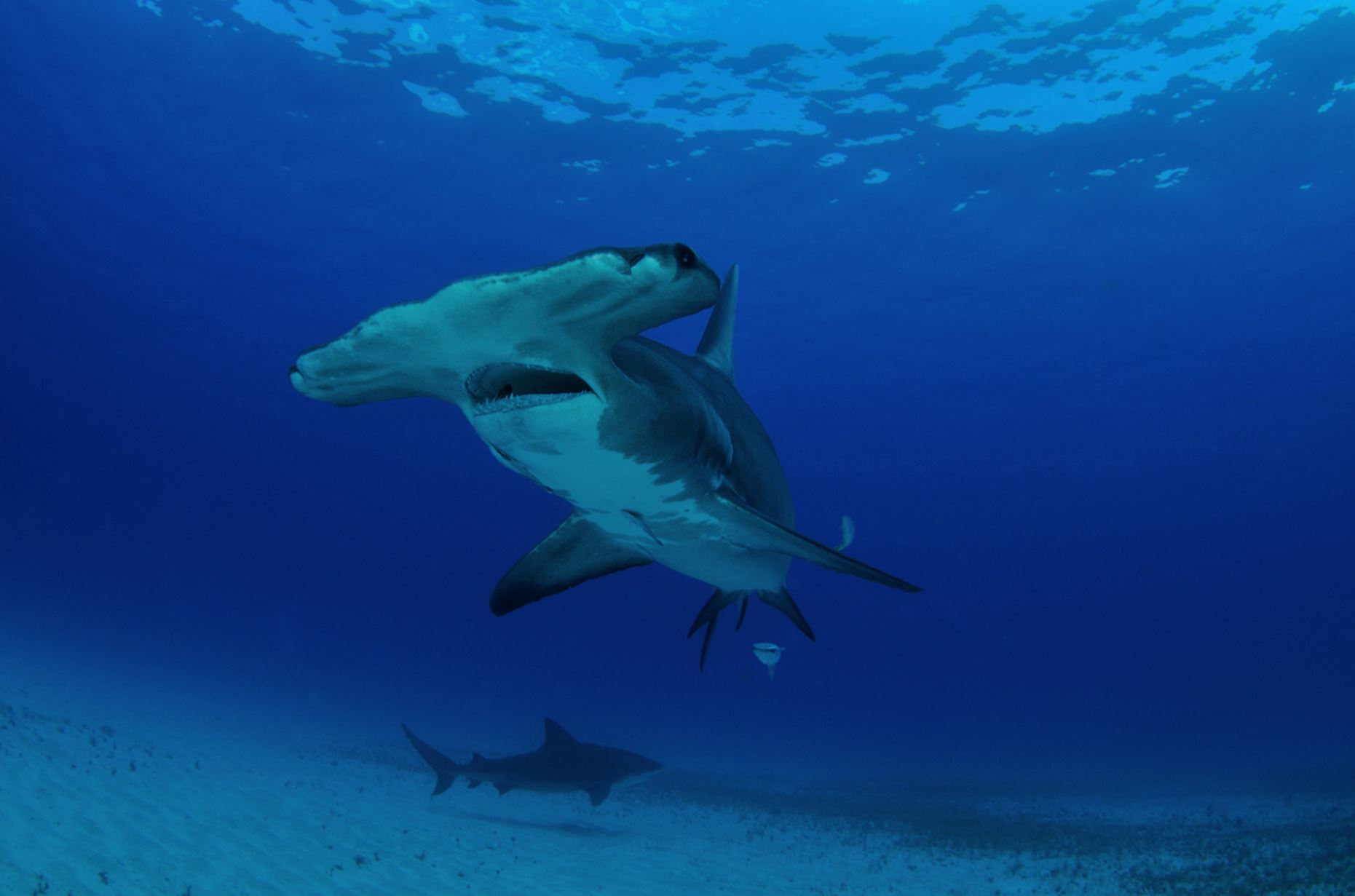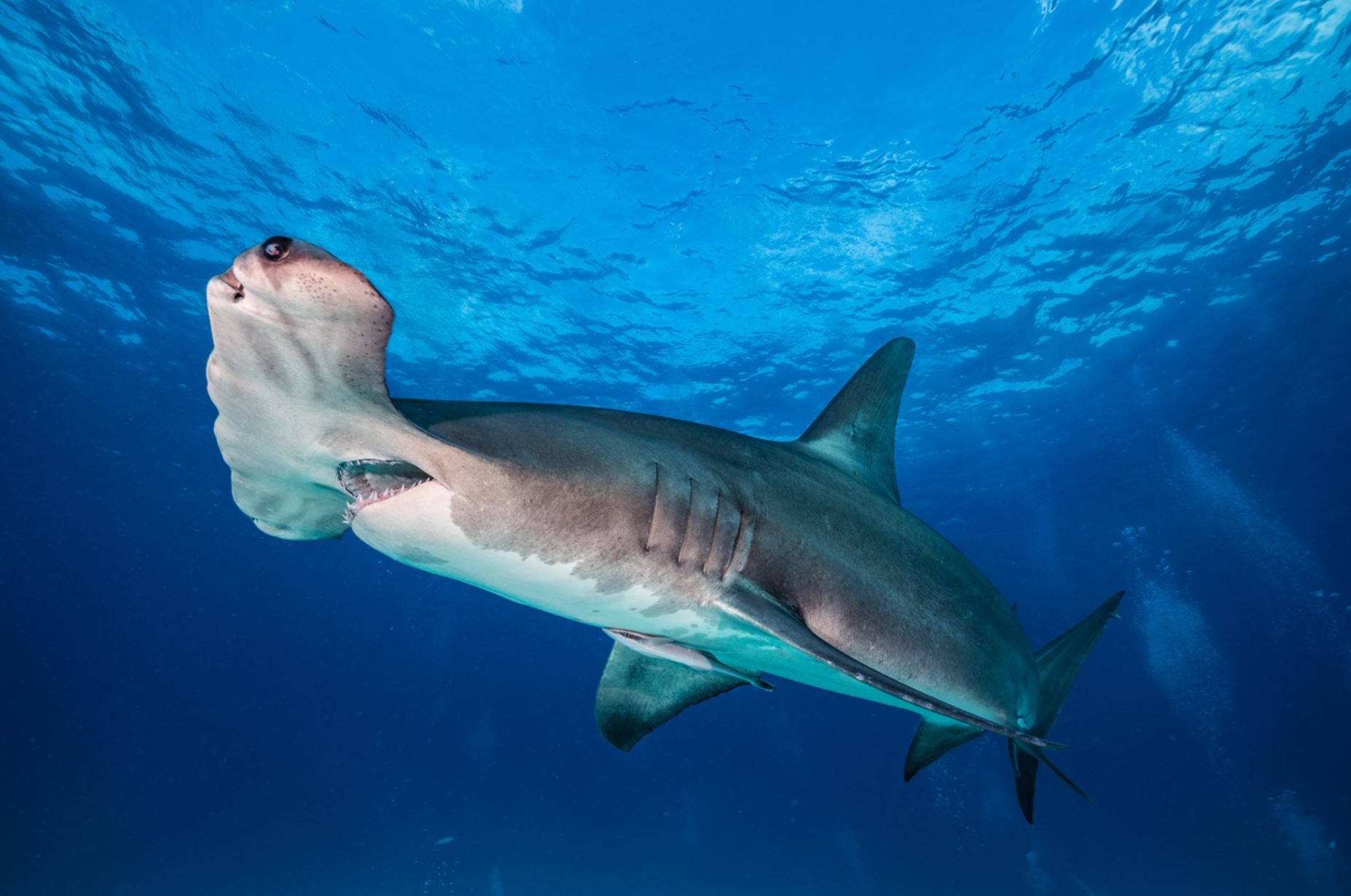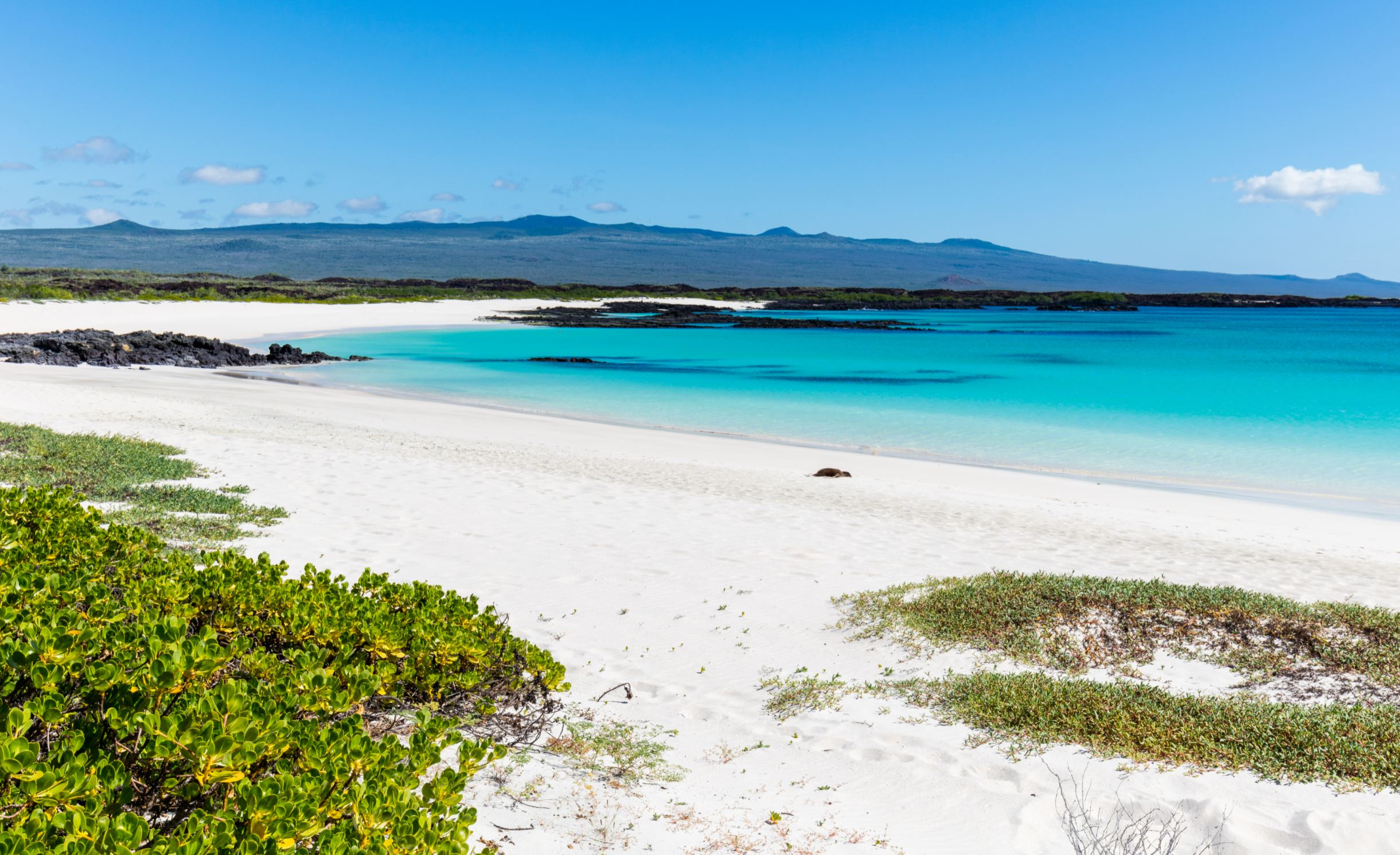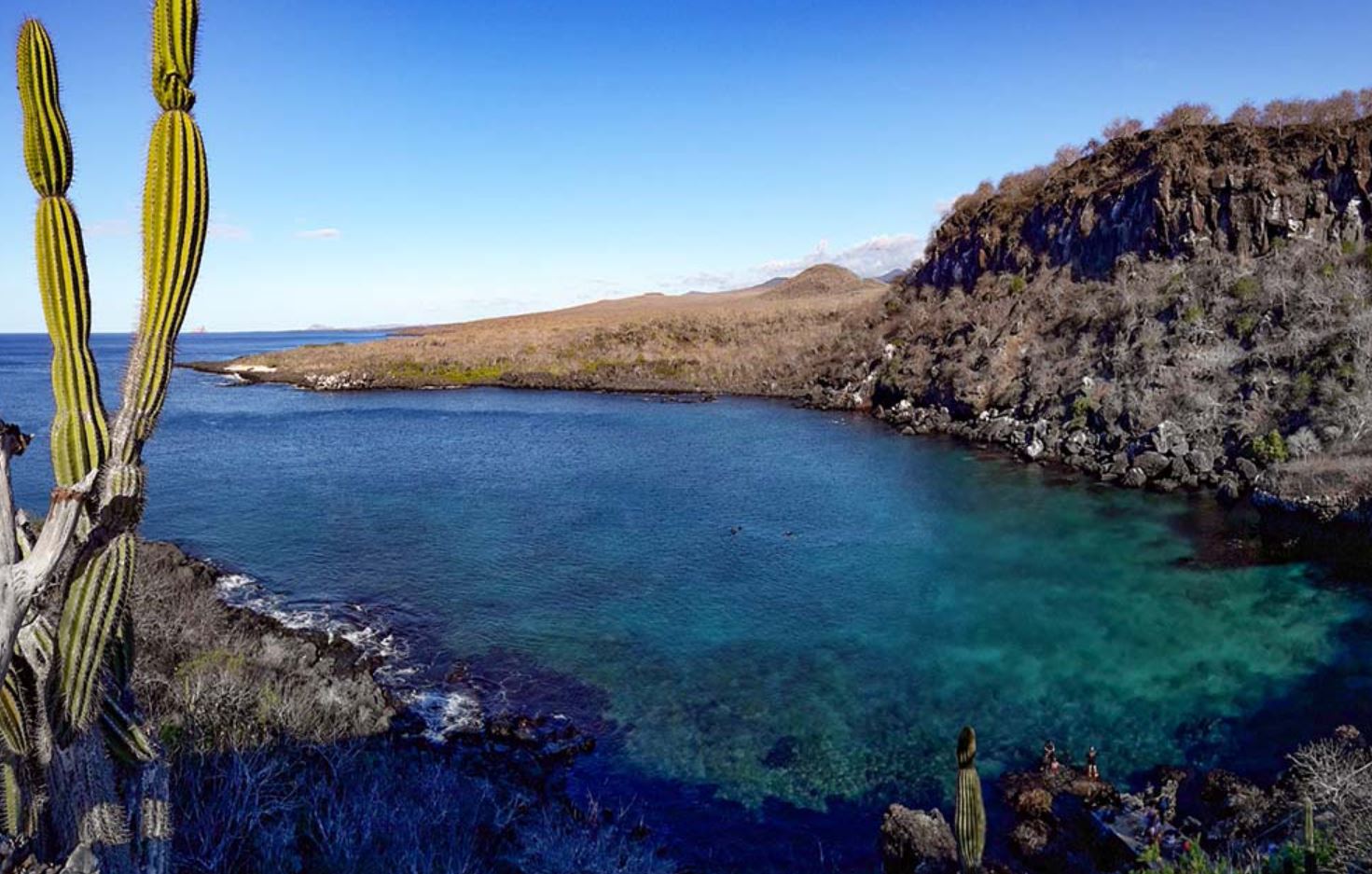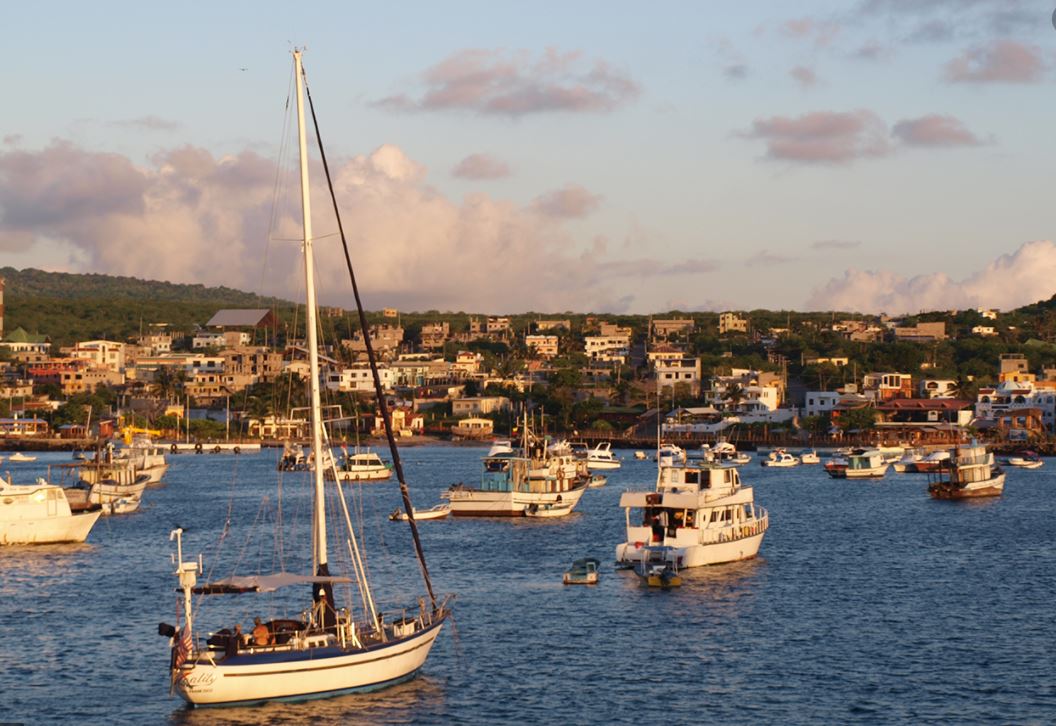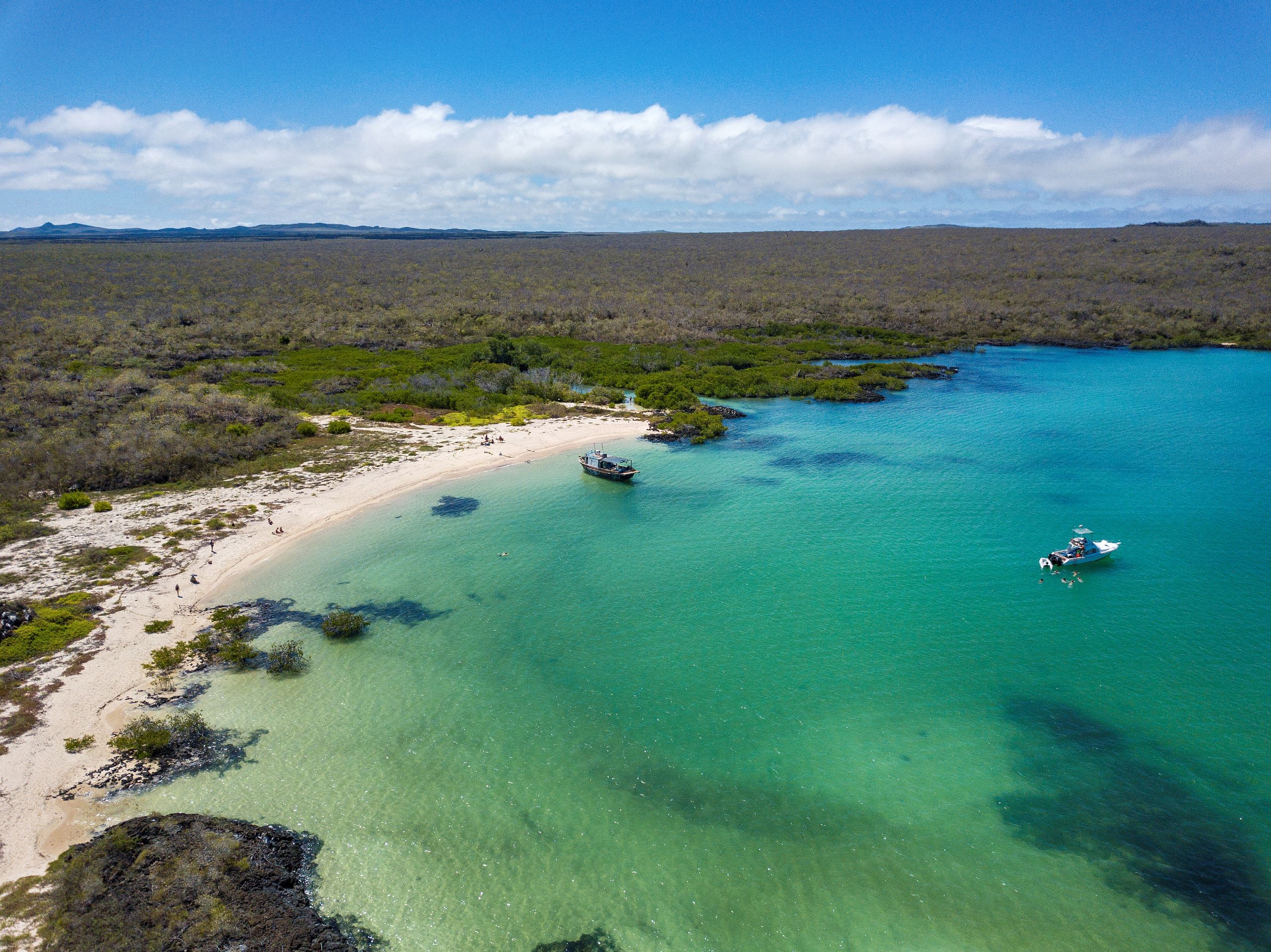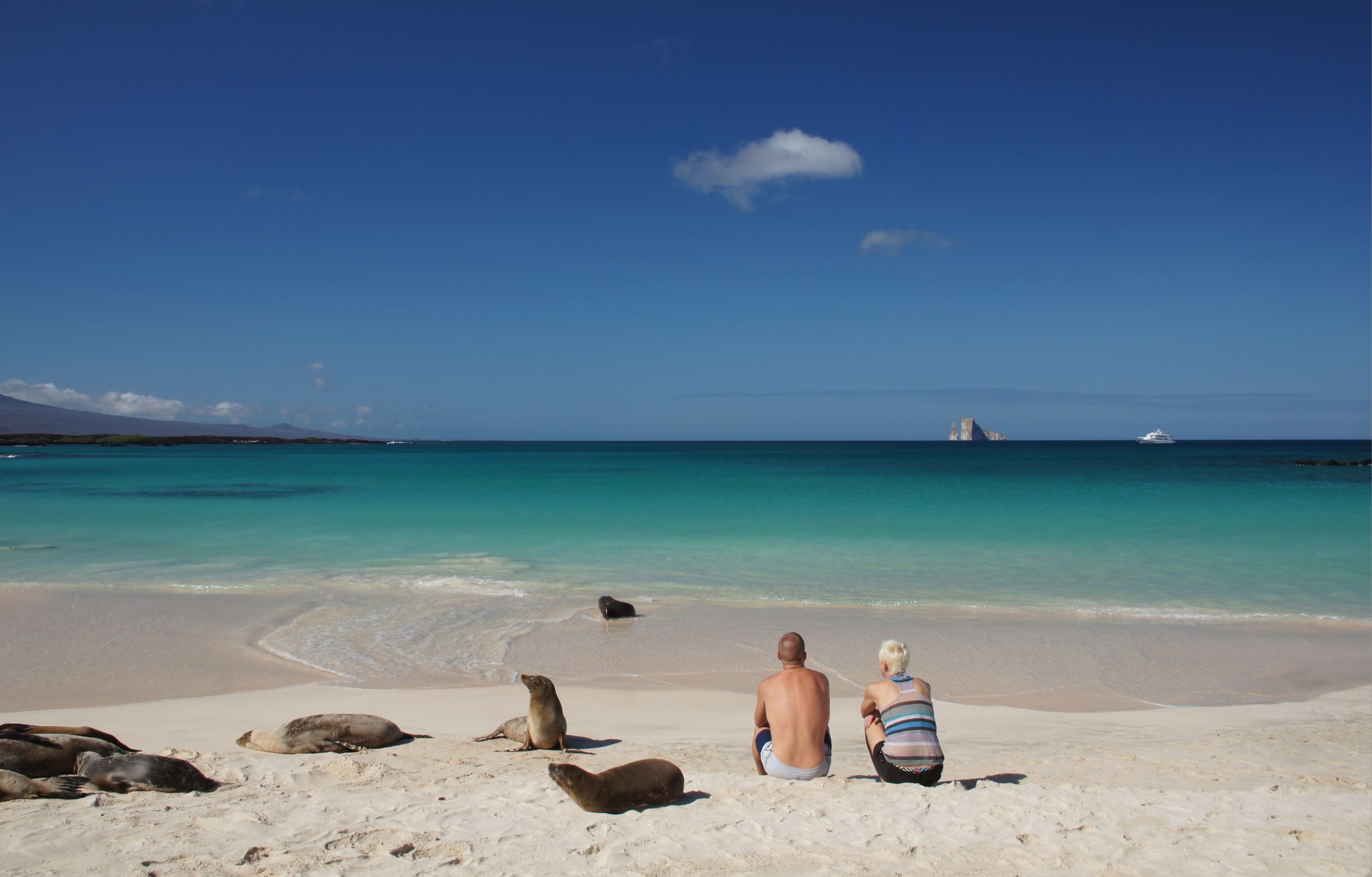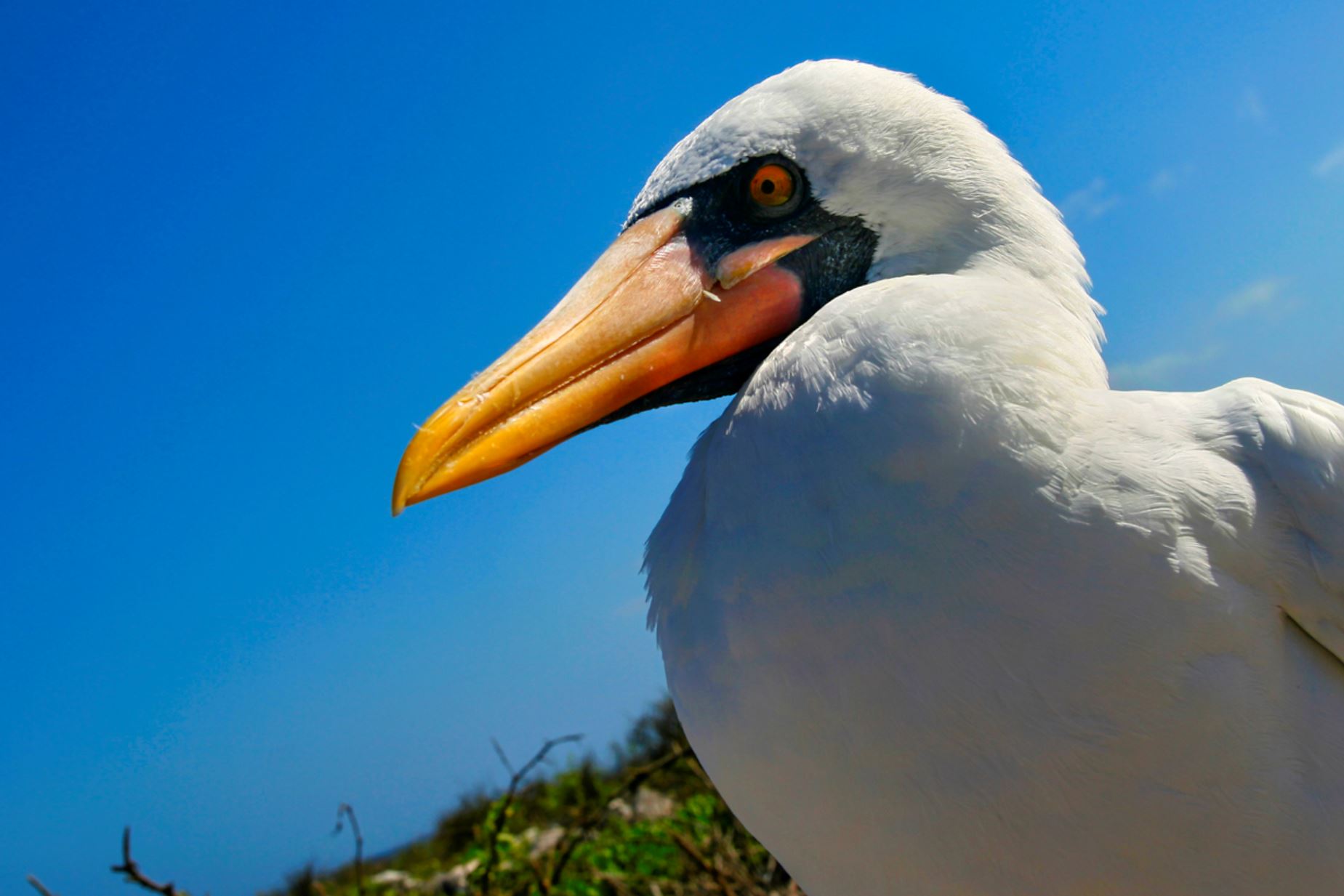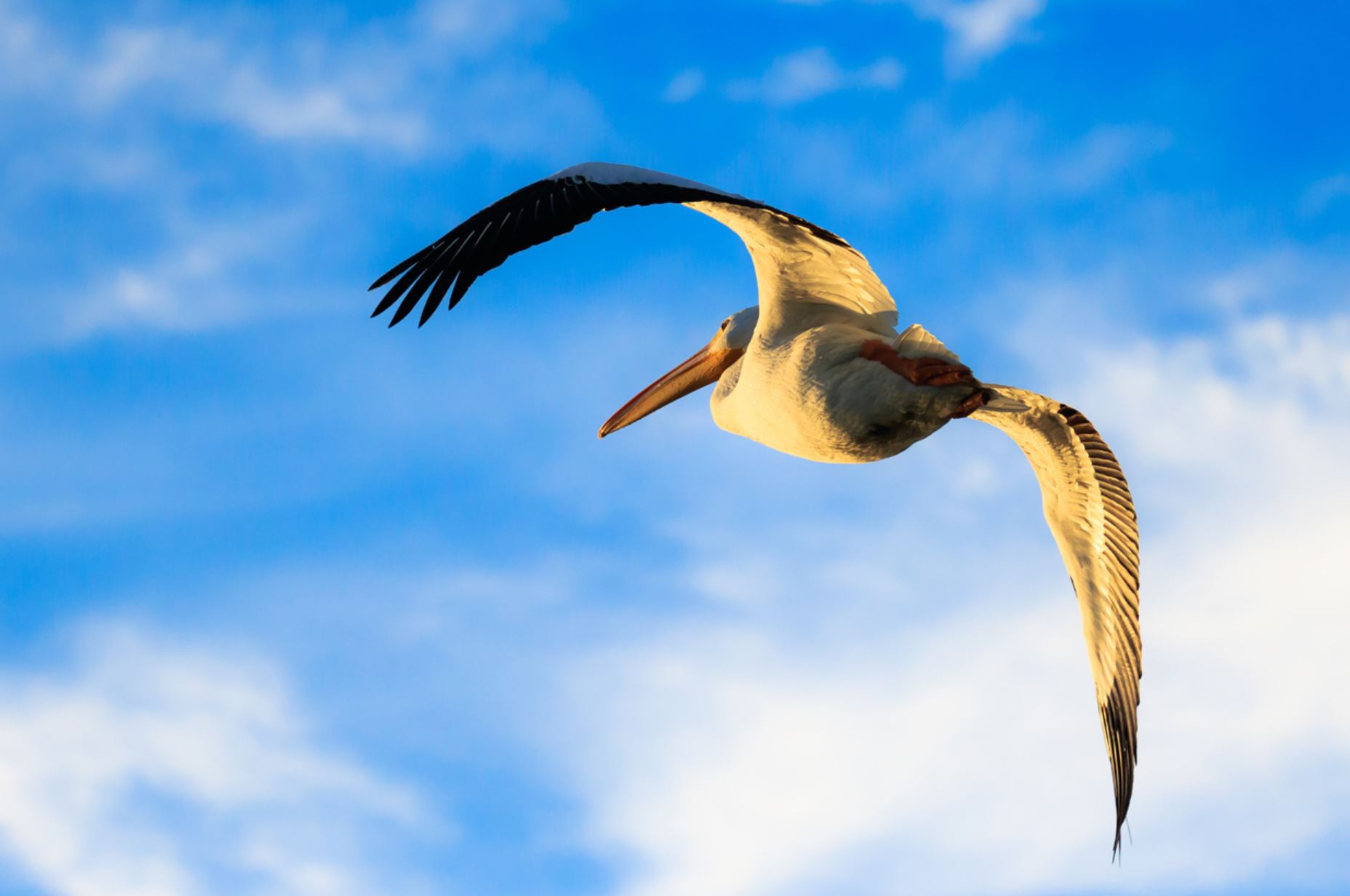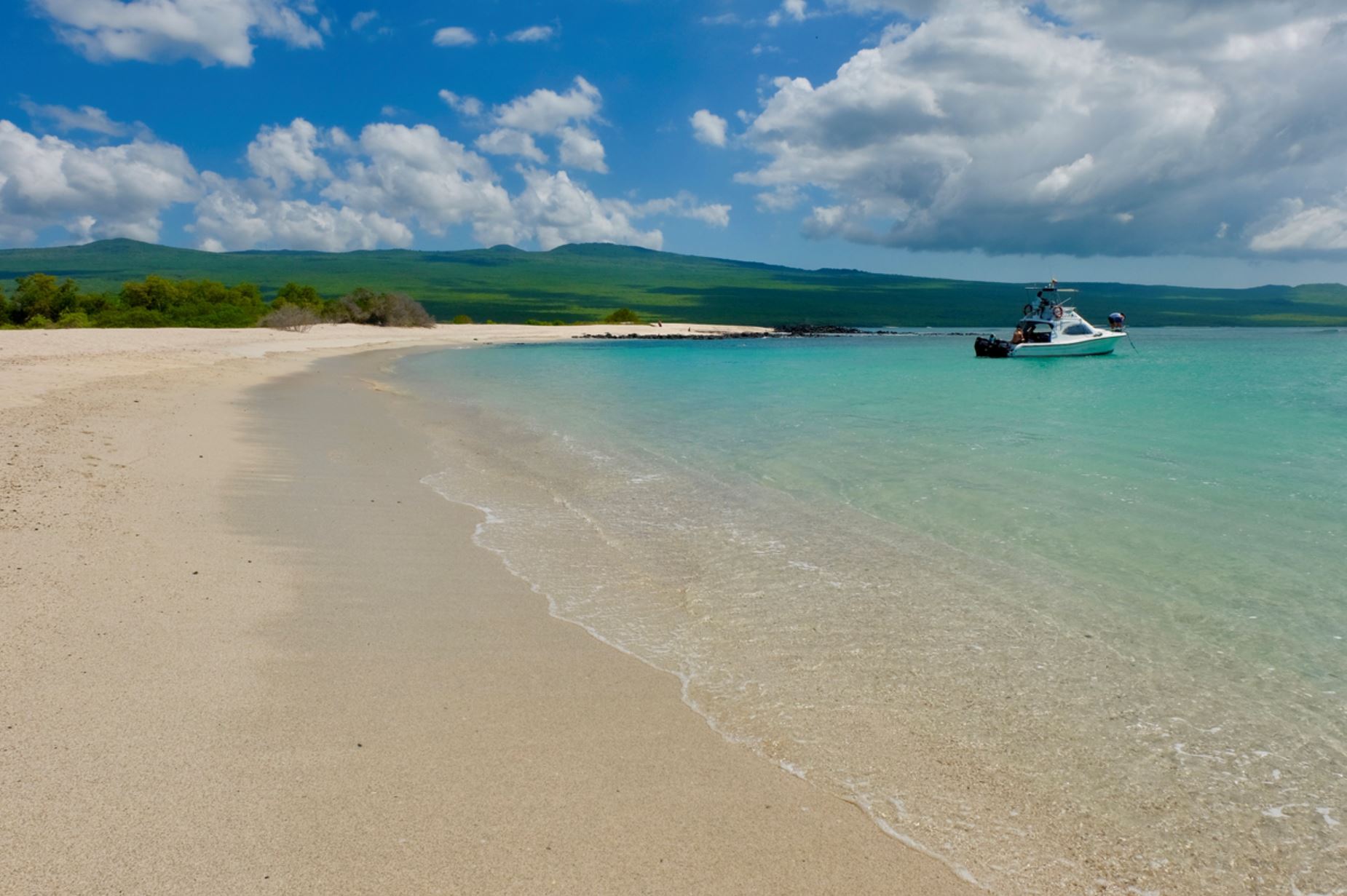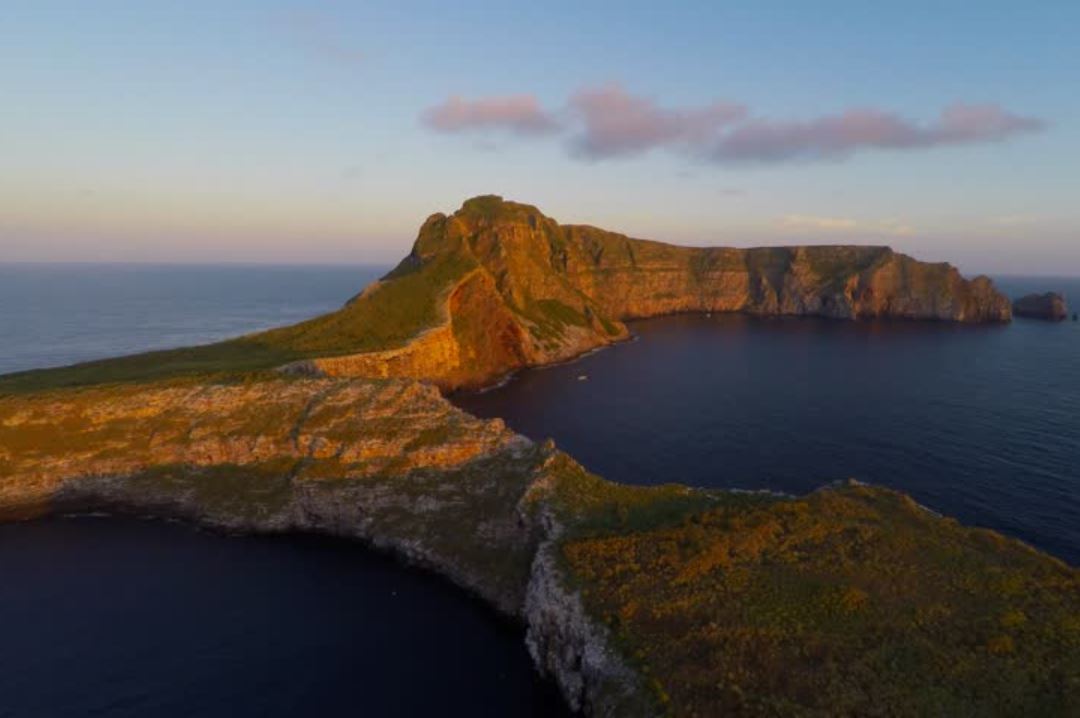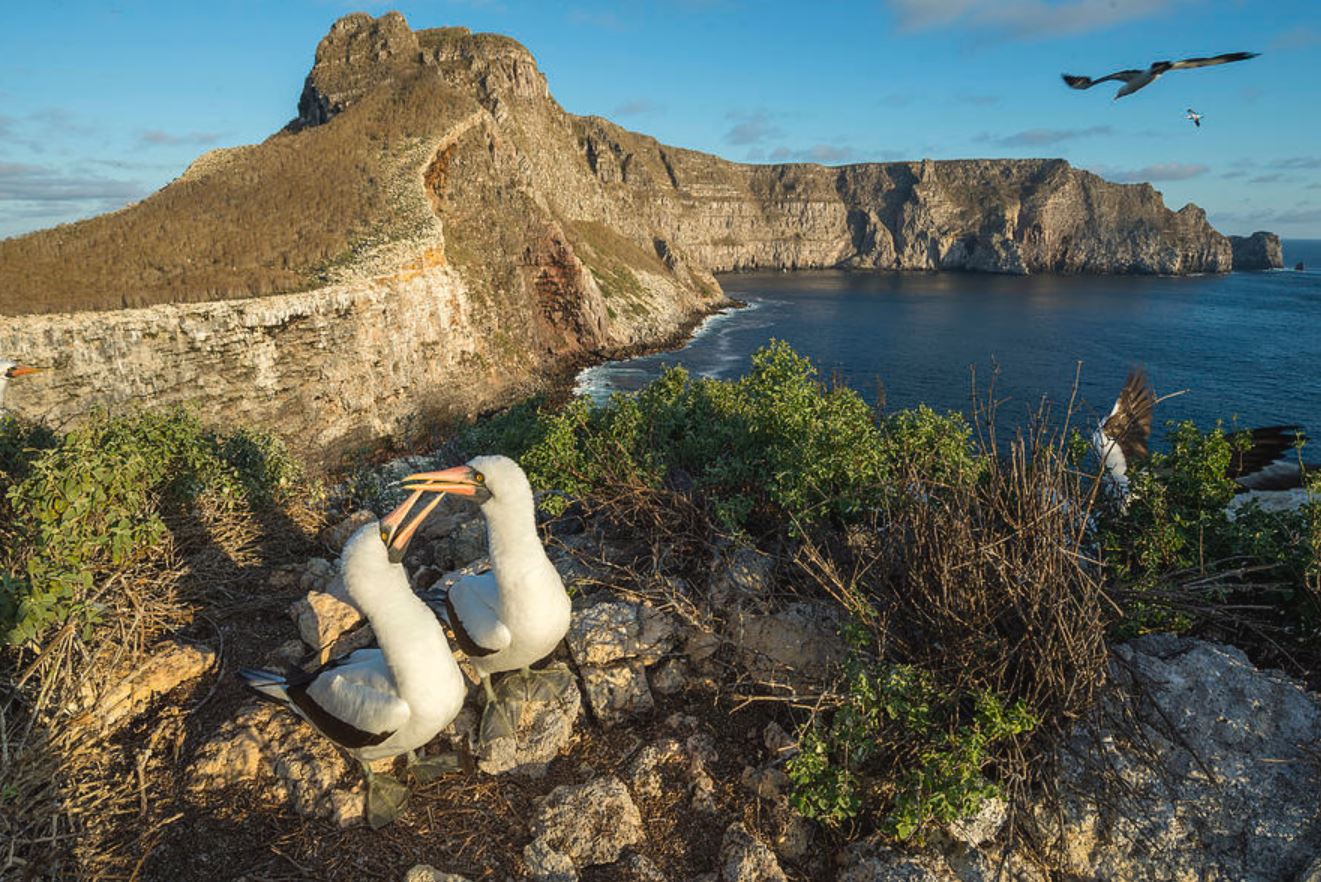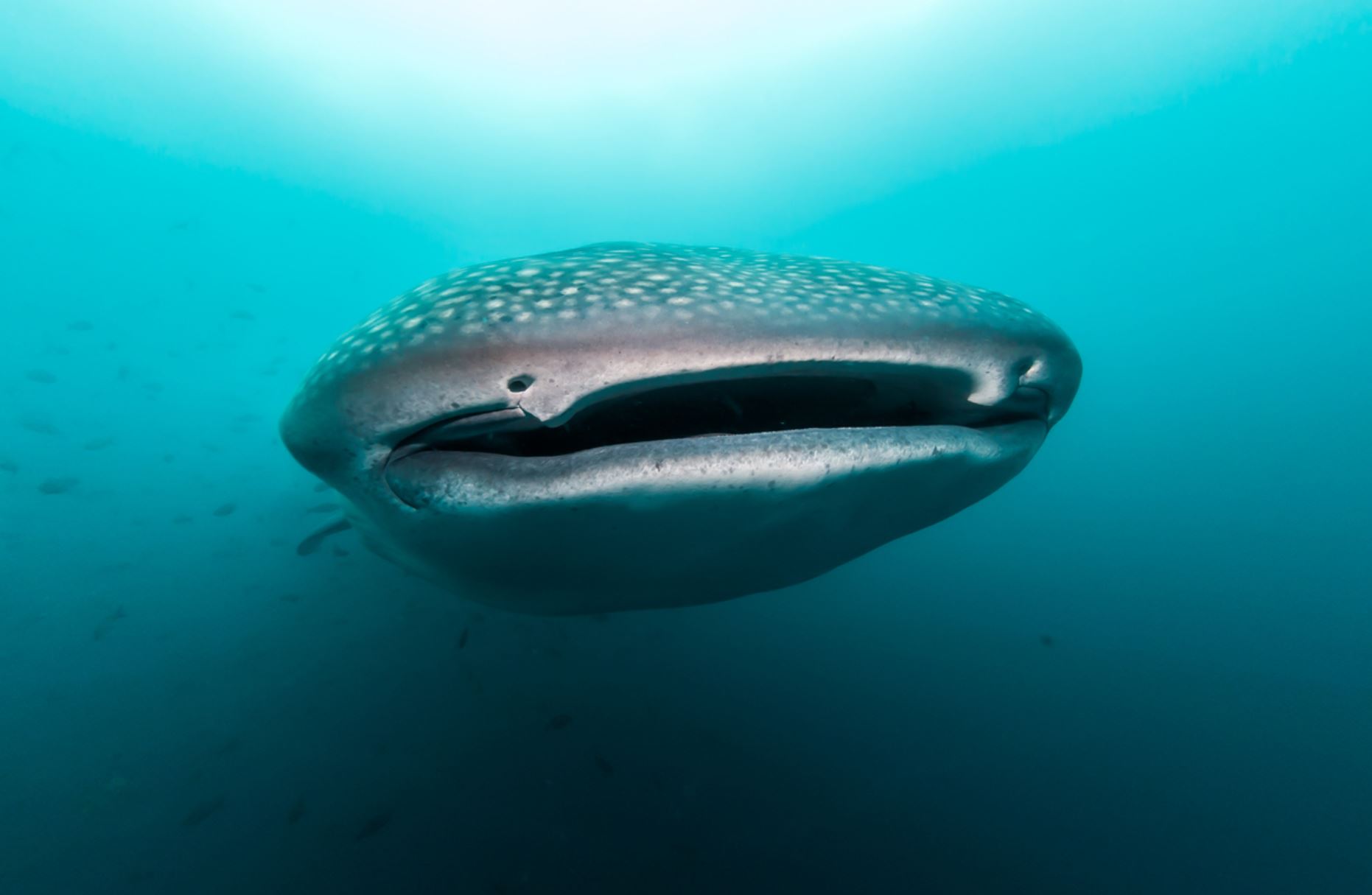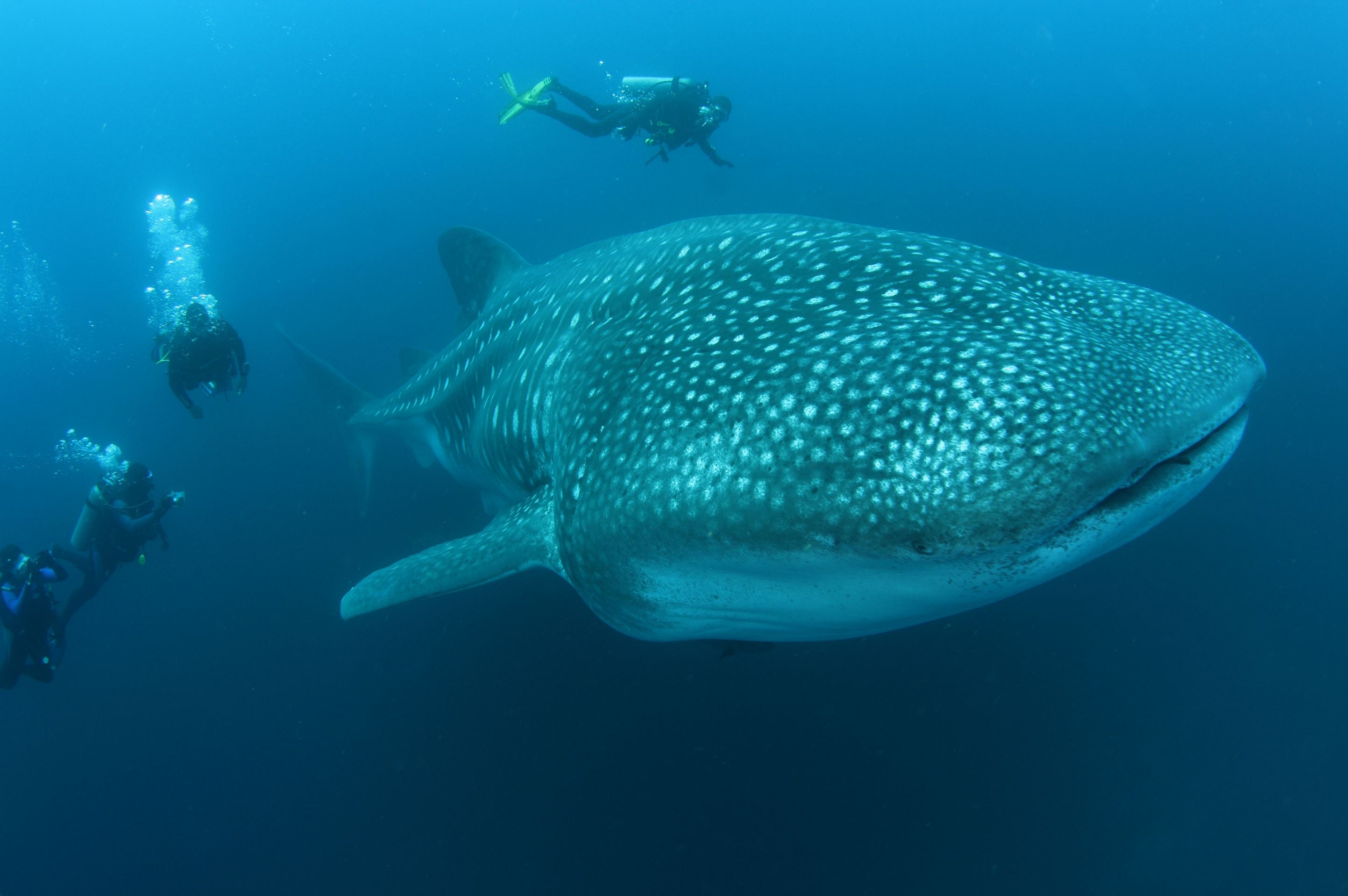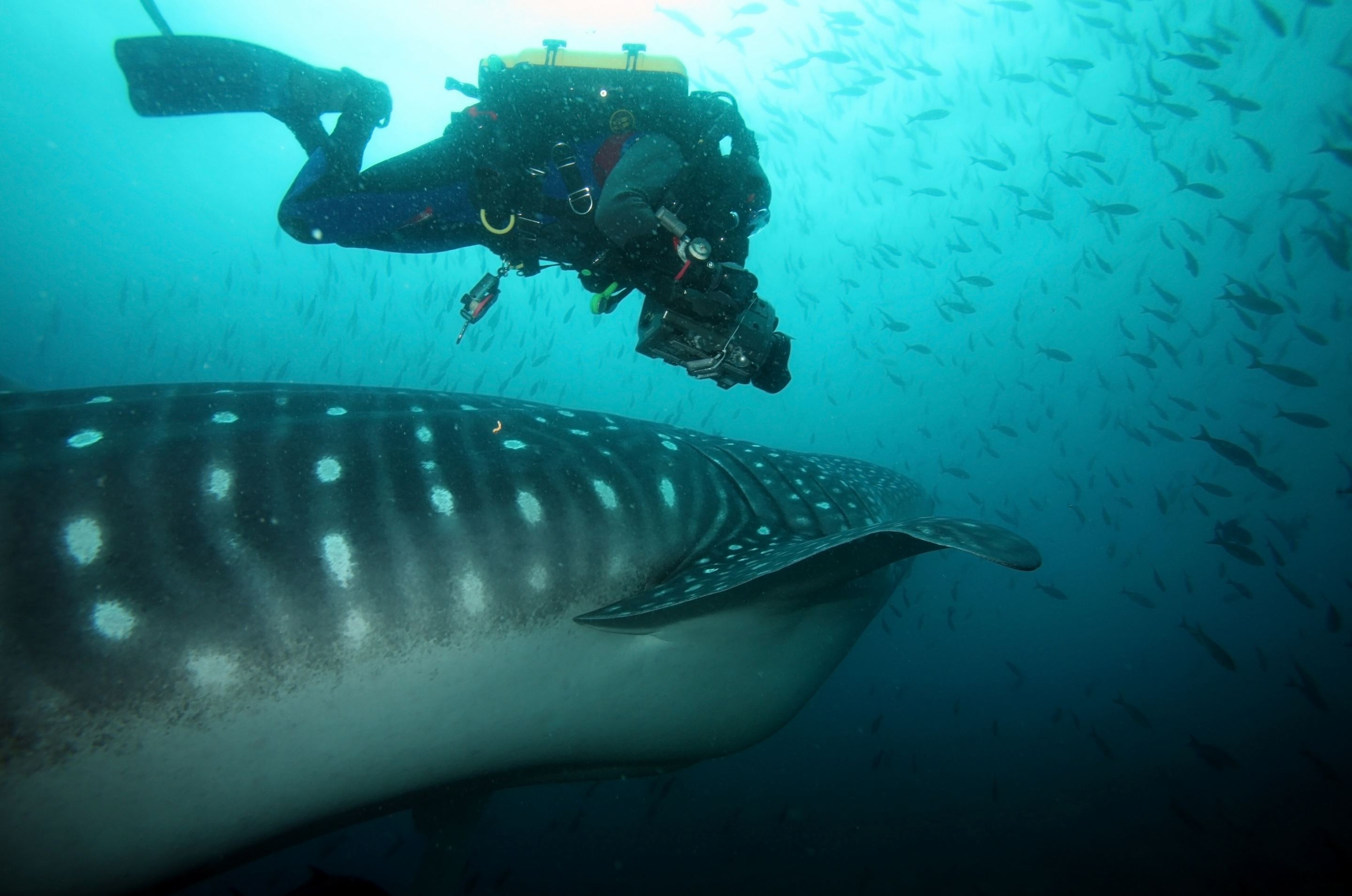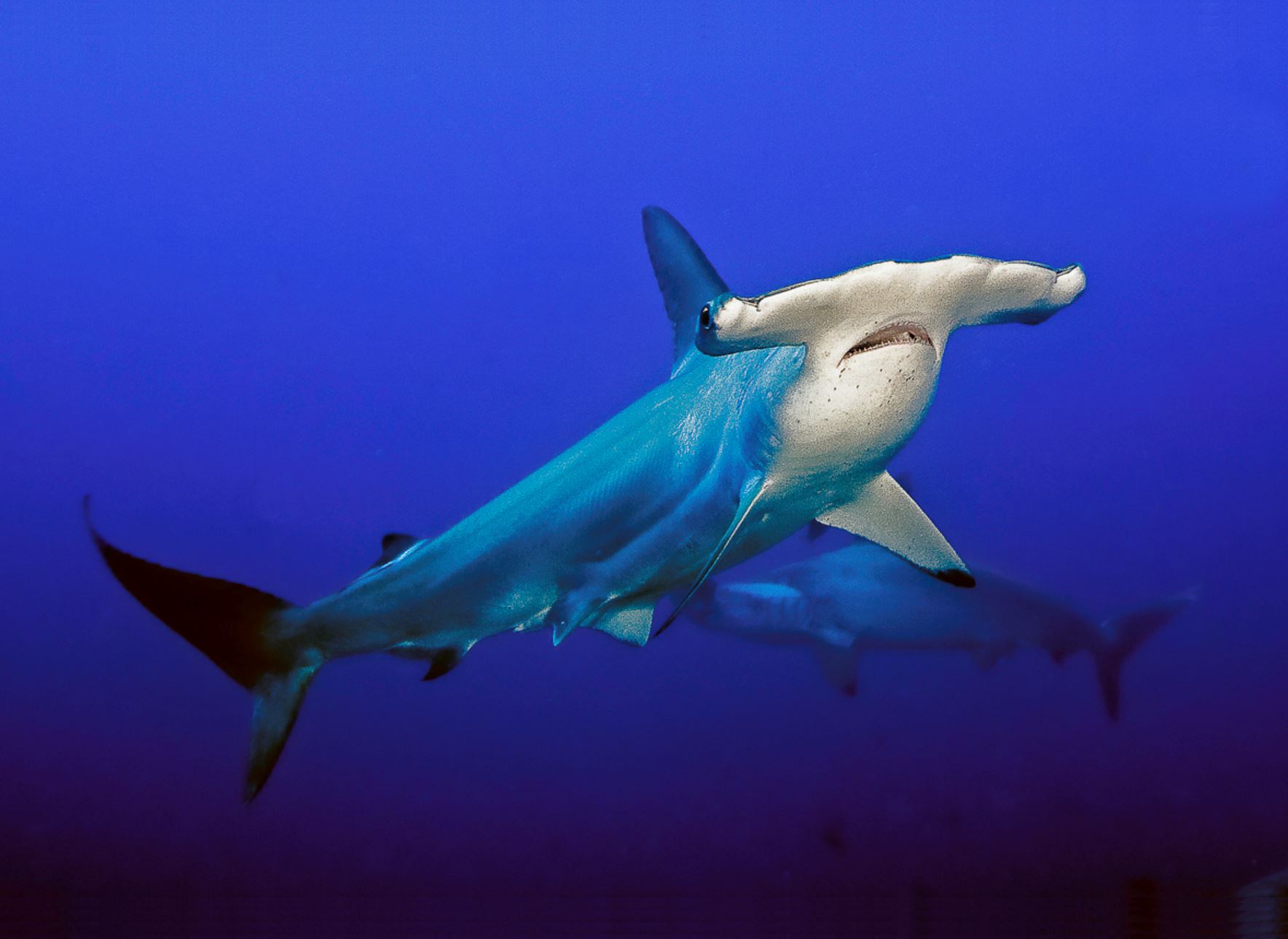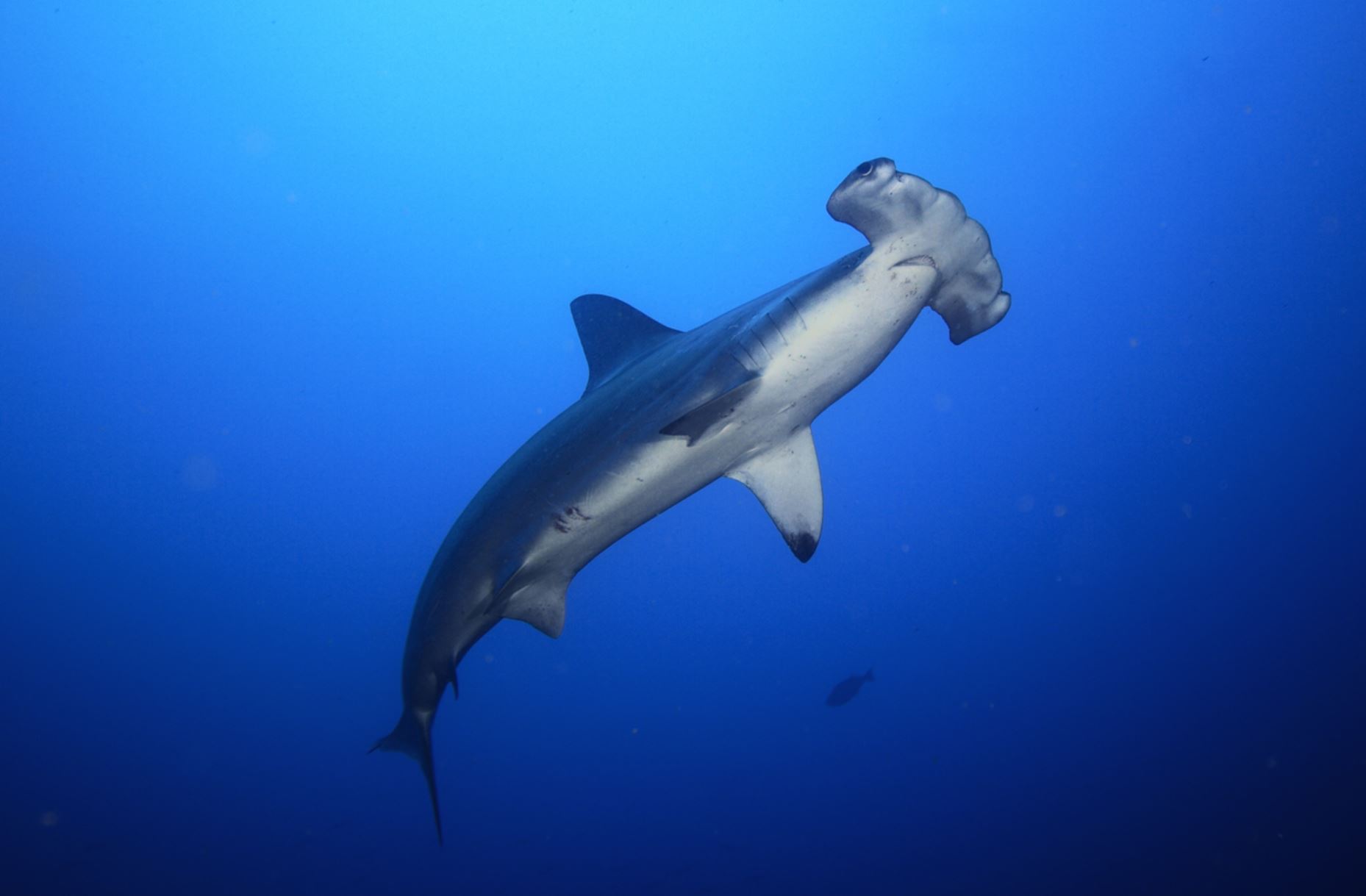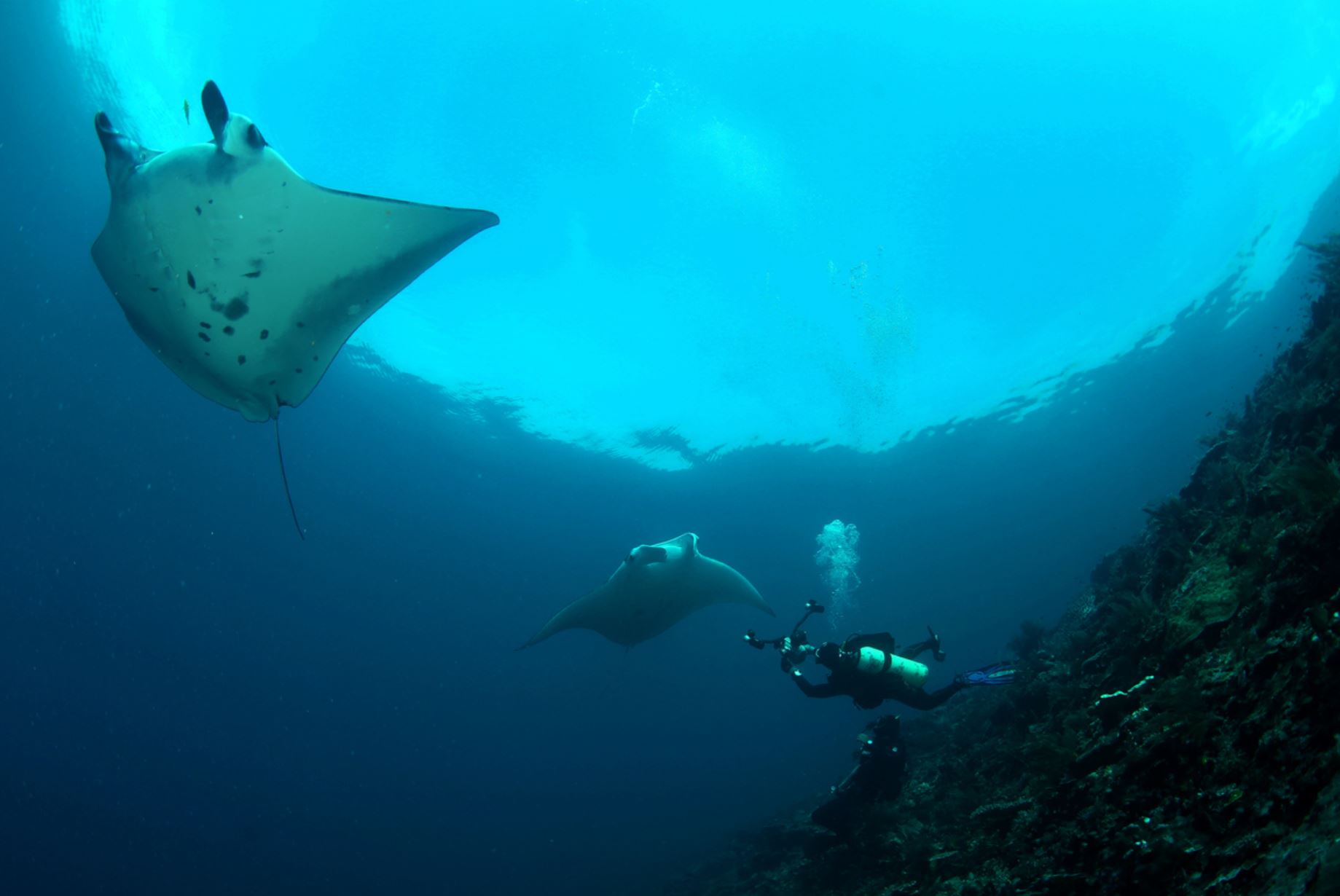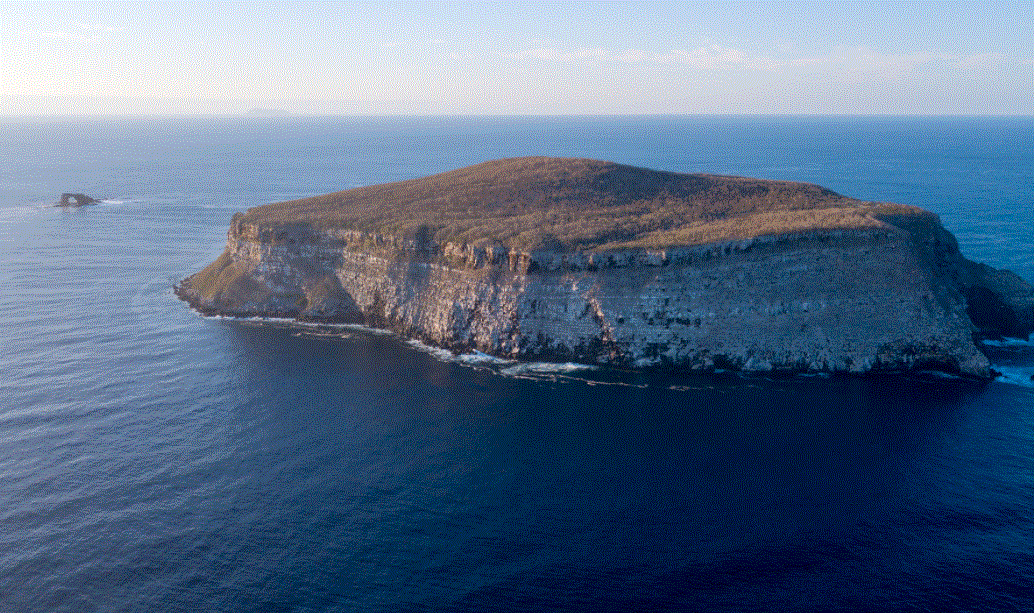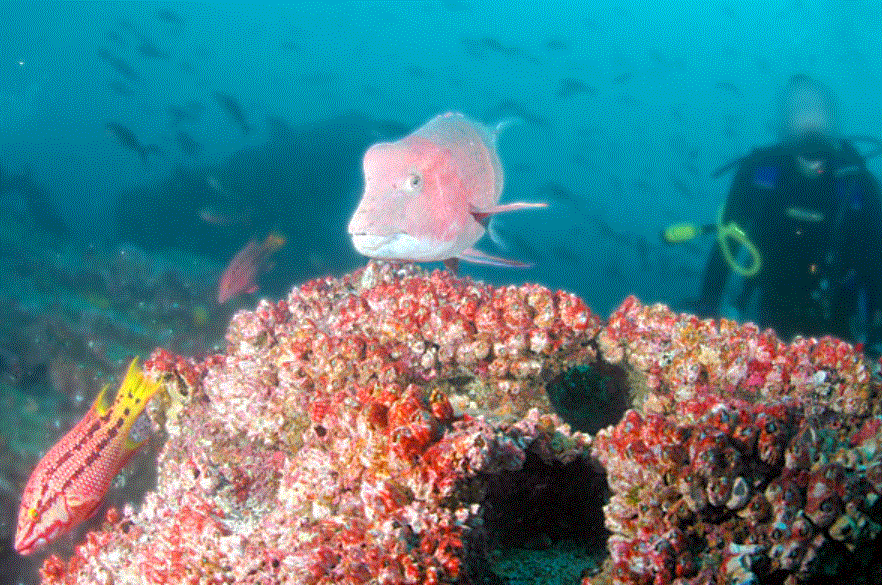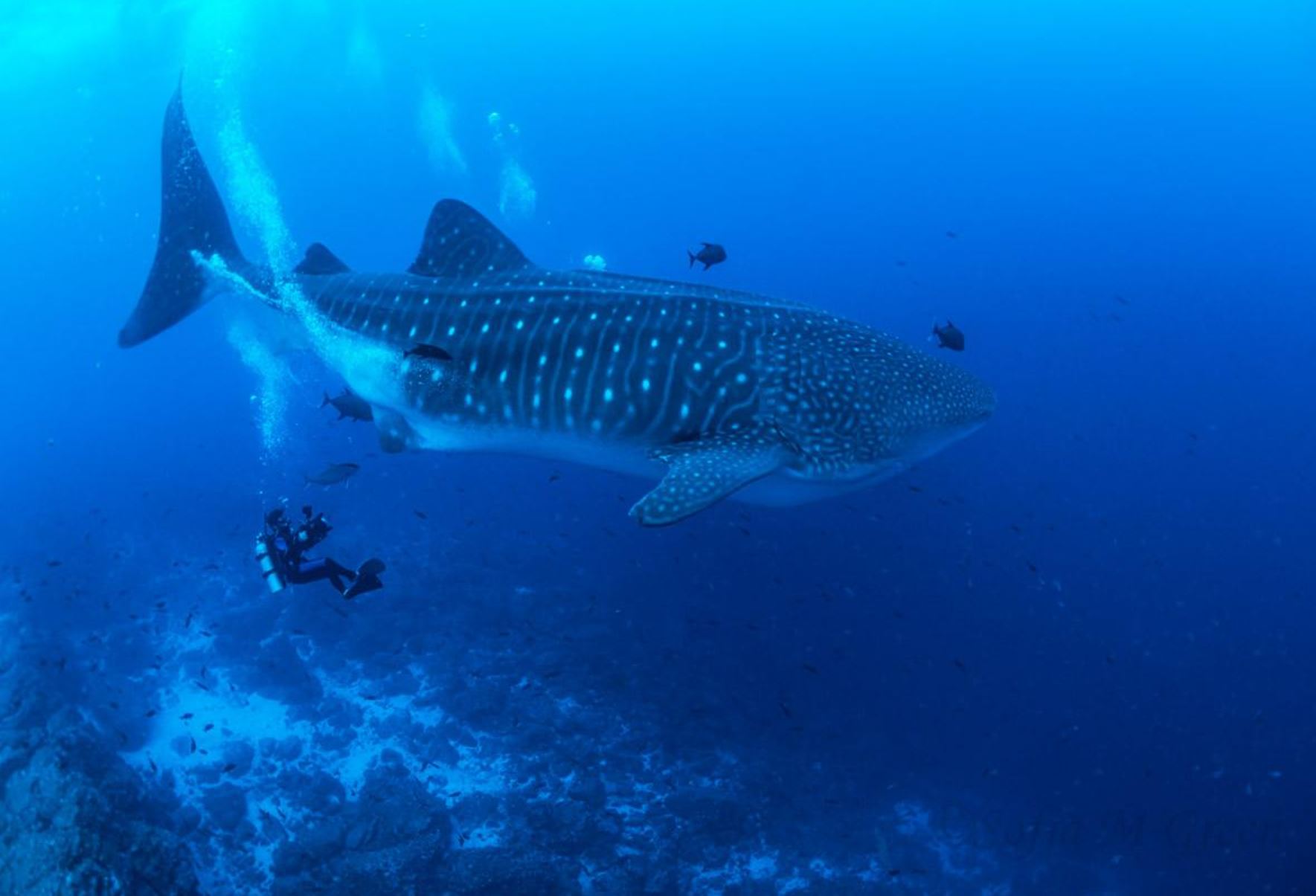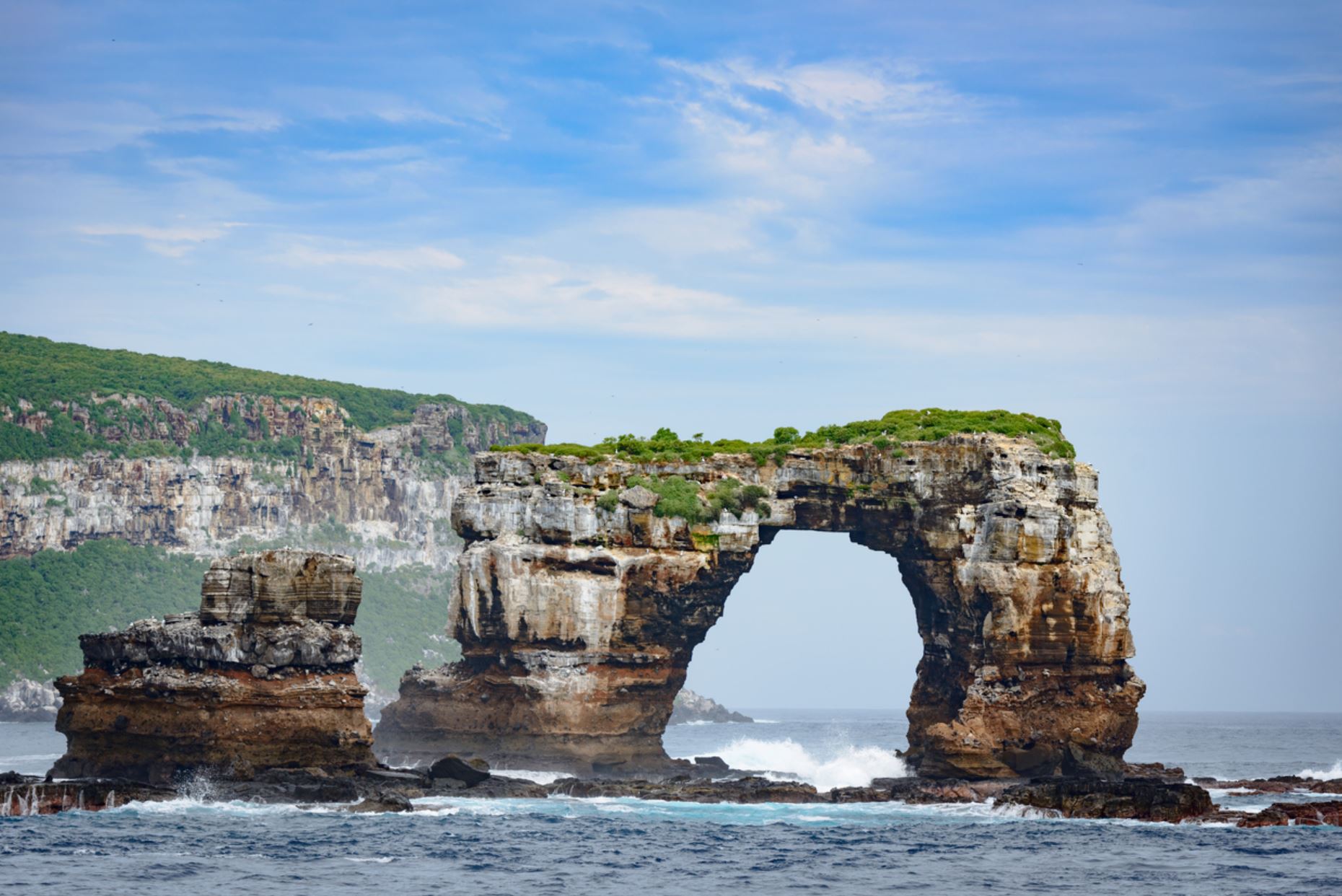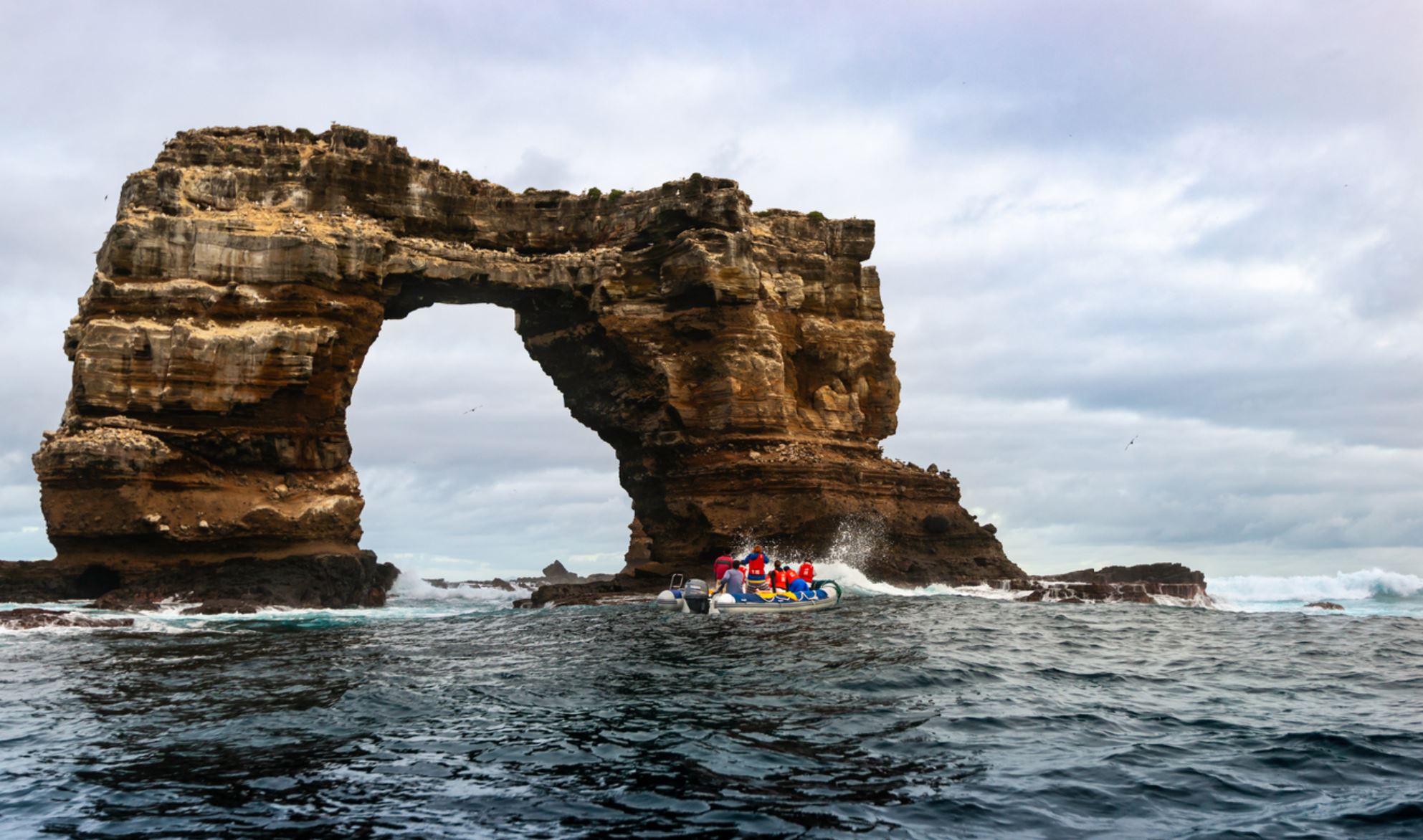Galapagos Hammerhead shark
The most common of the hammerhead sharks, scalloped hammerheads are a migratory species found in warm temperate and tropical waters of the Atlantic, Indian and Pacific Oceans. They can be told apart from their close relatives by the ‘scalloped’ front edge of their hammer-shaped head (which is called the cephalofoil). The cephalofoil has evolved to improve vision and to provide a larger area for the electroreceptors that the sharks rely upon for hunting prey on or under the sediment.
The body is slender and is a brown-bronze colour on top and white below. The teeth are narrow backwards-facing triangles, perfect for seizing prey that they can eat whole rather than having to take bites out of larger prey. Their diet ranges from schooling fish such as sardines, herrings and mackerel, to stingrays, squid and even crustaceans.
As with all hammerhead species, they have viviparous reproduction meaning that pups are nourished by a placental link to the mother much like mammals, and are born alive and fully functional. The gestation period lasts between 9-12 months and litter sizes can be large, ranging from 12-40 pups. Pups are born in shallow coastal areas and measure just 30-55 centimetres. Predation on pups by other sharks is high.
The Galapagos Marine Reserve (GMR) is one of the few places on Earth where scalloped hammerhead sharks can be seen gathering together in large schools of up to several hundred. The exact reason behind this schooling behaviour remains a mystery. In 2017, it was also found that scalloped hammerheads have nursery sites in the GMR. The average lifespan of a Galapagos Hammerhead shark is between 20 – 30 years.
Around the northern islands of Darwin and Wolf and occasionally around Kicker Rock you can see Hammerhead sharks with a bit luck. Hammerhead sharks are in the Galapagos Marine Reserve all year round but their abundance is highest in January and lowest in May. Mating and pupping seasons in Galapagos are currently unknown.
The scalloped hammerhead is an increasingly targeted species by commercial and illegal fisheries for their fins as these are highly valued in the Asian market for shark fin soup. They are very vulnerable to being caught as bycatch by trawls, purse-seine nets, gillnets and longlines. A large number of pups are also caught through artisanal coastal fisheries.
Scalloped hammerhead sharks are listed on Appendix II of CITES meaning that all international trade of this species must be registered. Within the Galapagos Marine Reserve, scalloped hammerheads are protected by law and, in 2007, Ecuador issued two new decrees which established better controls.
Animal Group: Marine Life
Scientific Name: Sphyrna mokarran
Animal Average Size: 2,5 – 4,2 m
Animal Average Weight: 80 - 100 kg, max. 152 kg
Places where you may see this animal in Galapagos: Darwin, Wolf, San Cristobal (Kicker Rock)
Pictures
Islands where you can see the animal with a little luck:
San Cristóbal
One of the oldest and closest to the continent, located on the east of the archipelago, which means it is the farthest of the hot spot of all, about 200 kilometers away from it with no volcanic activity. It is formed by four volcanoes bonded together and is the most humid island due to underground aquifers and fresh water flows. The English named it Chatam because of the British Prime Minister William Pitt of Chatam. It holds the biggest fresh water lake of the archipelago called El Junco, located on the south center part of the island about 660m above sea level. San Cristobal is one of the two only places where the Red Footed Booby can be found in a nesting colony in Punta Pitt visiting site.
This island is the capital of the archipelago, Puerto Baquerizo Moreno, with a population of about 7 thousand people. Human development started on the early 1832, firstly on the highlands on a sugar production settlement. An Interpretation Center was developed in town, where visitors can learn about the biological and historic facts that conform the islands.
Charles Darwin Journey on San Cristobal. This is the first Island visited by Charles Darwin, and his first impression of the dry coast he saw was of a deserted and isolated place. He did not find the tropical richness he expected, but he had the chance to collect the first specie that later on would be the start of his Theory of Evolution, the San Cristobal Mockingbird.
Punta Pitt visitor site is one of the two only places where the Red Footed Booby can be found in a nesting colony and offers an amazing red landscape full of Sesuvium, a very special endemic plant specie that turns color depending on the season. It has a magnificent beach formed with Peridot, a sparkly mineral creation that shines green with sunlight.
Cerro Brujo visitor site is the only place in the archipelago where Red Footed Boobies, Nasca Boobies and Blue Footed Boobies are found nesting together.
Tijeretas visitor site is the very first point that Charles Darwin visited on his journey. Not far from the interpretation center, there is a calm water rocky bay, a magnificent snorkel area and view site for nesting Frigate Birds, animal from which the place takes its name, Tijeretas.
Cerro Colorado visitor site on the southwest side of the island holds the facility of the Tortoise breeding Center, an semi natural area built for the purpose of rebuilding the tortoise population of the island and their conservation.
Visitor sites
El Junco Lagoon, Kicker Rock, La Galapaguera Jacinto Gordillo Breeding Center, Interpretation Center Gianny Arismendi , Tijeretas Hill, Lobo island, Pitt Point, Puerto Baquerizo Moreno, Puerto Chino, Witch Hill
Wolf
Wolf (and Darwin Islands) are non-inhabited outlying islands in the Galapagos archipelago. The islands are small, and are extinct volcano tops. Darwin Island is the smaller of the two, and is just 0.46 square miles, or 1,2 square kilometers in size. Wolf Island is a bit bigger, measuring 0.5 square miles or 1,3 square kilometers in size. However, the tiny islands themselves are not the primary reason for a visit to this area – rather, the main purpose of a trip here is to dive. There are a variety of diving options, and a massive array of marine life to feast your eyes on, once you get into the depths of the ocean. It is for this reason that Wolf and Darwin are considered the best islands for diving in Galapagos. These Galapagos diving islands attract numerous divers every year, due to the remarkable underwater scenes that can be experienced here. Here we will explain the highlights of Wolf Island and Darwin Island, the best time to go, how to get there, the activities there and the wildlife you will have a chance of seeing, as well as our Insider recommendations for your trip to these fantastic Galapagos diving islands.
Wolf and Darwin Islands Highlights:
Wolf and Darwin Islands are very highly rated among divers, and this site is considered among the best worldwide. One of the best dive sites here is known as El Derrumbe, and it is famous for its tremendous array of diverse marine life. There is considered to be a massive abundance of sharks and other marine predators here, and in fact, studies have shown that this area has the largest shark biomass worldwide.
Best time to Go to Wolf and Darwin Islands:
The best time to visit Wolf and Darwin Islands will depend on what type of weather you like, and how strong you prefer your currents to be.
The marine life is more plentiful between the months of June to November, as during this time, the Humboldt current sweeps up, bringing with it an array of nutrients which attracts diversity of life in the water. However, the currents can be a fair bit stronger during these months too, and particularly in August and September. The water is also cooler during these months. The remaining months (December to May) are warmer, though you may expect some rain. There is still plenty to see, but the diversity of marine life will be slightly less during these months. That is unlikely to detract from the experience overly, however.
The months of June through September and December/January may be considered high season. Since not all Galapagos Islands cruises offer diving, and that means there are limited spaces, in these months you will want to book well in advance.
Getting to Wolf and Darwin Islands
Wolf and Darwin Islands are only accessible to visitors travelling on a liveaboard scuba diving boat. As mentioned above, not all Galapagos Islands cruises offer diving – in fact, very few do, and they are liveaboard boats with diving itineraries. This means that if you want to visit Wolf and Darwin Islands you will need to do so on a liveaboard boat as it will not be possible for regular visitors on a standard Galapagos cruise, or for visitors that have opted for a Galapagos land based option. A great cruise offering visits to these two islands is the popular and comfortable eg. Caliypso Galapagos Yacht covering its comprehensive itineraries. Please contact our Galapagos-Expert Christian Frobeen via E-mail info@frobeen.de or telephone +49 (0)7633-93993-60.
Wolf and Darwin Islands Wildlife
The marine life at Wolf and Darwin Islands is quite simply, spectacular. The cold currents that wash in bring a variety of different sharks, as well as whales and other interesting creatures. Shark types that can be seen here include Galapagos sharks, white tipped sharks, the great spotted whale shark, and even hammerhead sharks. In the water you may also see various types of rays, and in particular, manta rays. Sea turtles can also be spotted here. These highlights aside, you can also expect to see a wide variety of colorful fish.
The islands also have some interesting bird life to be seen. There are finches, and in particular, the vampire finch – so named, because it drinks the blood of both Nazca and red footed boobies, as well as other birds here. You will also likely see a variety of other sea birds too.
It is worth noting that there are conservation issues in this area, since it is so far from the central islands region of the Galapagos, and therefore difficult to enforce regulations there. This means that the site is at risk from unregulated activities such as fishing, or diving in unregulated boats. To control this, the Galapagos National Park has put in place a floating base at Wolf, so these waters can be better controlled.
Wolf and Darwin Islands Activities:
As can be seen from examining this guide to Wolf and Darwin Islands, the only activity that can be carried out here is diving and the site itself is not easy. There can be quite strong currents, so individuals coming to dive here need to be confident in their diving skills. Another activity that you might very well enjoy here is taking photographs of the interesting rock formation, Darwin’s Arch.
There is not much else to do in this remote, but fascinating area. Once you’re done with your dives and photography, you might simply kick back and enjoy a cold drink on the deck, reflecting on your extraordinary underwater experiences of the day.
Insider Recommendations for your visit to Darwin and Wolf Islands
Our Insider recommendation for a visit to Darwin and Wolf Islands is that you are well qualified, since the currents can be strong here. We suggest that you are at a minimum, advanced qualified in diving. Remember, you can only visit this Galapagos visitor site on a diving liveaboard trip.
Why not contas us and we can help you sort out your Galapagos diving trip. We are experts in Galapagos bookings and can help you find your ideal Galapagos Island trip on a liveaboard that includes a stop at Wolf and Darwin Islands – contact us today to find out how we can help. Especially our Galapagos-Expert Christian Frobeen can over you a fantastic diving-trip to Galapagos (www.galapagos.de, info@frobeen.de)
Visitor sites: El Derrumbe, North islet/La Banana, Shark Bay, The Cave Dive Site, The Landslide Dive Site, La Ventana islet
Darwin
Isla Darwin (English Culpepper Island) is an uninhabited island that is located in the far northwest of the Galapagos Islands, part of Ecuador, and with an area of just over 1 km² is the northernmost and westernmost island of the archipelago. It was named after Charles Darwin and was created around 700,000 years ago. The closest island is Wolf and is 34 km further south. Many seals, marine iguanas, sea turtles and numerous bird species live on the island, including the vampire finches. The island of Darwin is under extensive protection by the national park administration, entry is strictly forbidden, special permits for scientists or film teams have rarely been granted in recent years. Local fishermen can acquire fishing licenses that are limited in time and quantity, but are only allowed to use fishing rods, not nets and certainly not with long lines.
Places to visit:
Darwin's Arch About 2 km southeast of the island around the cliffs on the rock in front of Darwin's Arch is one of the most interesting diving areas in the world. It is particularly known for the large schools of hammerhead sharks, which often include over 200 animals here, but also other large fish such as manta rays, eagle rays, cow nosed rays, reef sharks, whale sharks can be observed here in large numbers. The very fish-rich waters around the island are inhabited by large dolphin populations, orcas and other whales often pass by.
Mr. Frobeen can give you precise information about the ships.
Mr. Frobeen will be happy to advise you by phone at +49 (0)7633 9399360 or via email info@frobeen.de
If you want to book, what are the payment methods?
The reservation is gratis as an option.
If you want to make an fixed booking, there is to pay a deposit of 20%.
The remaining payment is due 4 weeks before departure. In individual cases, such as diving cruises, other rules apply. Information on request.
- Your payments are insured against bankruptcy!

